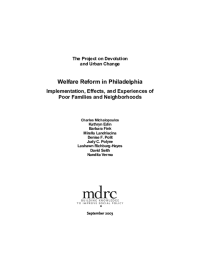Welfare Reform in Philadelphia
Implementation, Effects, and Experiences of Poor Families and Neighborhoods
The 1996 welfare reform law called for profound changes in welfare policy, including a five-year time limit on federally funded cash assistance (known as Temporary Assistance for Needy Families, or TANF), stricter work requirements, and greater flexibility for states in designing and managing programs. The law's supporters hoped that it would spark inno-vation and reduce welfare use; critics feared that it would lead to cuts in benefits and to widespread suffering. Whether the reform succeeds or fails depends largely on what happens in big cities, where poverty and welfare receipt are most concentrated.
This report - one of a series from MDRC's Project on Devolution and Urban Change - examines the specific ways in which reform unfolded in Philadelphia. The study uses field research, state records, surveys and ethnographic interviews of welfare recipients, and indi-cators of social and economic trends to assess TANF's implementation and effects. Because of the strong economy and ample funding for services in the late 1990s, the study captures welfare reform in the best of times but focuses on the poorest families and neighborhoods.
Key Findings
- Pennsylvania substantially changed its welfare system. The state focused its welfare-to-work program on employment, expanded and simplified the provisions that allow wel-fare recipients to keep part of their welfare checks if they work, and instituted two time limits: a 24-month limit that requires recipients to work or participate in a work activity for 20 hours per week and a 60-month lifetime limit on welfare receipt. In Philadelphia, implementation of the law was lenient in some respects. During the first two years on welfare, recipients were asked to conduct an eight-week job search but otherwise were not held to a strict work requirement. At the 24-month limit, many parents who were not working were placed in subsidized jobs. In addition, families received extensions to the lifetime limit if they participated in assigned activities.
- In Philadelphia, between 1992 and 2000, welfare receipt declined and employment in-creased. TANF seems to have encouraged long-term recipients to leave the rolls faster, to have increased employment (but mostly unstable employment), and to have raised the likelihood that some families would return quickly to welfare. Because positive trends in welfare receipt and employment began prior to TANF, it is clear that the economy and other factors also played important roles in these outcomes.
- A longitudinal survey of welfare mothers living in the city's poorest neighborhoods suggests that, over time, more worked and fewer received welfare, while household in-comes increased. These changes were not necessarily a result of welfare reform alone; the gains may also be a reflection of the strong economy and of women and children growing older. Despite their increased average income, virtually all the women were poor or near poor in 2000, and many encountered barriers that might have kept them from working. In addition, improvements in employment and income were concen-trated among high school graduates.
- Between 1992 and 2000, social conditions in the city's poorest neighborhoods generally improved. For example, crime rates declined; housing values increased; and more preg-nant mothers received adequate prenatal care. Despite these improvements, the number of neighborhoods with high concentrations of welfare recipients declined only slightly over time, and Philadelphia's welfare caseload remains concentrated in neighborhoods with some of the worst social and economic conditions in the city.
This study's findings are consistent with an earlier Urban Change report on Cleveland, and they counter the notion that welfare reform leads to service retrenchment and a worsening of conditions for families and neighborhoods. Further study is needed to determine how welfare reform fares in a less favorable economy and what effects time limits will have in the long term.







